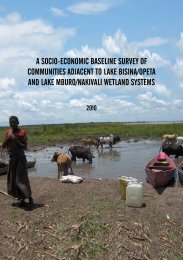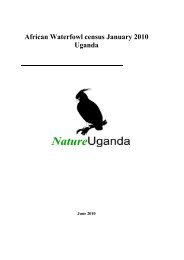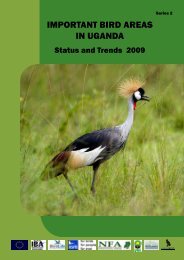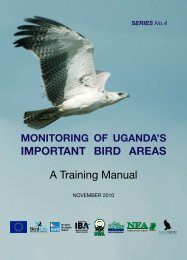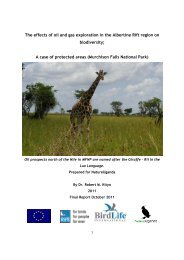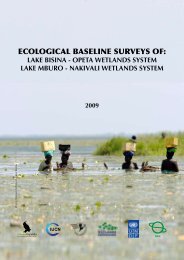the economic valuation of the proposed ... - Nature Uganda
the economic valuation of the proposed ... - Nature Uganda
the economic valuation of the proposed ... - Nature Uganda
Create successful ePaper yourself
Turn your PDF publications into a flip-book with our unique Google optimized e-Paper software.
which include schist’s, phyllites, quartzites and<br />
amphibolites. The gneisses and granites are generally<br />
fairly uniform and give rise to little variation in resistance<br />
to soil erosion o<strong>the</strong>r than along joints and fracture<br />
planes. Under humid conditions, granitic rocks are very<br />
liable to chemical decomposition and, in most parts <strong>of</strong><br />
<strong>the</strong> area, <strong>the</strong> rocks are now wea<strong>the</strong>red to a considerable<br />
depth. The overlying metasediments, by contrast, are<br />
heterogeneous and include hard resistant bands <strong>of</strong><br />
quartzite and, to a lesser extent, amphibolite, alternating<br />
with s<strong>of</strong>t, easily eroded schist’s.<br />
Soils<br />
The soils in <strong>the</strong> forest reserve are strongly influenced<br />
by <strong>the</strong> local topography. The forest lies on <strong>the</strong> Buganda<br />
catena which comprises <strong>of</strong> red soils with incipient<br />
laterisation? on <strong>the</strong> slopes and black clay soils in <strong>the</strong><br />
valley bottoms. There are four principal members <strong>of</strong><br />
this catena which are described as follows, starting with<br />
those at <strong>the</strong> highest altitude:<br />
a. Shallow Lithosols <strong>of</strong> <strong>the</strong> highest ridge crests<br />
8<br />
consisting <strong>of</strong> grey and grey brown sandy loams<br />
overlying brashy, yellowish or reddish brown<br />
loam with laterite or quartzite fragments and<br />
boulders.<br />
b. Red Earths (Red Latosols) which cover most<br />
<strong>of</strong> <strong>the</strong> land surface and are strikingly apparent<br />
in <strong>the</strong> large conical termitaria dotting a ra<strong>the</strong>r<br />
monotonously green landscape. The soil pr<strong>of</strong>ile<br />
consists <strong>of</strong> up to 30 cm <strong>of</strong> brown sandy or clay<br />
loam overlying uniform orange-red clay to a<br />
depth <strong>of</strong> 3 m or more.<br />
c. Grey Sandy Soils appearing at <strong>the</strong> base <strong>of</strong> <strong>the</strong><br />
slopes <strong>of</strong> <strong>the</strong> catena <strong>the</strong>se may be derived from<br />
hill-wash or river alluvium. Underlying <strong>the</strong> sandy<br />
topsoils are fine sandy clays <strong>of</strong> a very pale grey<br />
colour mottled to orange brown.<br />
d. Grey clay usually water logged and occupied by<br />
papyrus stand at <strong>the</strong> base <strong>of</strong> <strong>the</strong> catena. Below<br />
this are sandy and even pebbly clays. Despite<br />
<strong>the</strong> waterlogged condition for most <strong>of</strong> <strong>the</strong> year,<br />
surface peat accumulation is rarely more than a<br />
few inches thick. The last two members <strong>of</strong> <strong>the</strong><br />
catena are very acid in reaction (pH 3.8 – 4.8) and<br />
are deficient in all plant nutrients except sulphur<br />
and magnesium.<br />
Due to <strong>the</strong> wea<strong>the</strong>ring, <strong>the</strong> soils are not so fertile and<br />
<strong>the</strong> fertility that is <strong>the</strong>re is because <strong>of</strong> <strong>the</strong> forest litter<br />
that decomposes and releases nutrients. However, <strong>the</strong><br />
cutting away <strong>of</strong> <strong>the</strong> forest will result into fur<strong>the</strong>r soil<br />
degradation because <strong>of</strong> <strong>the</strong> removal <strong>of</strong> <strong>the</strong> forest cover<br />
and subsequent loss <strong>of</strong> litter. It will also lead to quicker<br />
leaching <strong>of</strong> nutrients and higher soil erosion levels.<br />
2.3. PLANTS<br />
Three hunded sixty five plant species are known to occur<br />
in Mabira forest as recorded by Howard & Davenport<br />
(1996) and Ssegawa (2006). Of <strong>the</strong> species recorded in this<br />
reserve, nine are uncommon and have been recorded<br />
from not more than five <strong>of</strong> <strong>the</strong> 65 main forest reserves in<br />
<strong>Uganda</strong> (Howard & Davenport, 1996). Trees and shrubs<br />
recorded in Mabira but not previously known in <strong>the</strong><br />
floral region include Acacia hecatophylla, Aeglopsis<br />
eggelingii, Alangium chinense, Albizia glaberrima,<br />
Aningeria adolfi-friederici, Bequaertiodendron<br />
oblanceolatum, Cassipourea congensis, Celtis adolfi-<br />
fridericii, Chrysophyllum gorungosanum, Dombeya<br />
goetzenii, Drypetes bipindensis, Elaeis guineensis,<br />
Elaeophorbia drupfera, Ficus dicranostyla, Khaya<br />
antho<strong>the</strong>ca, Lannea barteri, Manilkara multinervis,<br />
Musanga cecropioides,Myrianthus holstii, Neoboutonia<br />
macrocalyx, Rawsonia lucida, Rhus ruspolii, Rinorea<br />
beniensis, Schrebera alata, Tapura fischeri and Warburgia<br />
ugandensis. Restricted-range trees and shrubs recorded<br />
from Mabira include Caesalpinia volkensii, Antrocaryon<br />
micraster, Chrysophyllum delevoyi, Elaeis guineensis,<br />
Lecaniodiscus fraxinfolius, Tricalysia bagshawei,<br />
Chrysophyllum perpulchrum, Ficus lingua and Picralima<br />
nitida. The Mahogany species namely, Entandrophrama<br />
cylindricum, Entandrophragma angolense and Khaya<br />
antho<strong>the</strong>ca are listed as globally threatened species<br />
(IUCN, 2000). O<strong>the</strong>rs include Hallea stipulosa, Lovoa<br />
The Economic Valuation <strong>of</strong> <strong>the</strong> Proposed Degazettement <strong>of</strong> Mabira CFR | 2011



